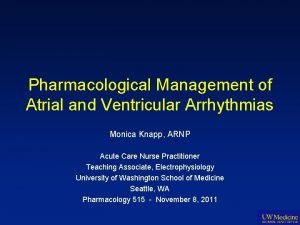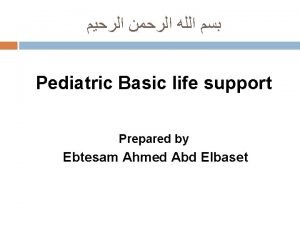Medical Practice Variations Among OutofHospital Cardiac Arrest OHCA

- Slides: 1

Medical Practice Variations Among Out-of-Hospital Cardiac Arrest (OHCA) Patients: Race/Ethnicity and Insurance Factors Alejandra Gonzalez, BS, Bryn Mumma MD, MAS Introduction Healthcare disparities have been identified among out-of–hospital cardiac arrest (OHCA) patients, the most common cause of cardiac death. 1 Decreased odds of cardiac catheterization has been found to be associated with non-White race and non-private insurance at the patient level among California 24/7 Percutaneous Coronary Intervention (PCI) centers. 2 Our current work expands on this research by identifying specific clinical practices, such as cardiac catheterization regardless of rhythm, use of advanced therapeutics and targeted temperature management, associated with race and insurance status of patients within California. With this research we wish to aid the process of eliminating healthcare disparities among California OHCA patients by identifying these correlations. Medicare status. The 24/7 PCI centers were coupled with this OSHPD patient data to serve as our study population, using proportion self-identified White vs. non-White Latino patients and proportion Medicare patients as the predictors of clinical practices. The dependent variable was the performance of specific clinical practices. The primary outcomes measured were cardiac catheterization and use of targeted temperature management (TTM) depending on rhythm. Secondary outcomes measured were use of extracorporeal life support (ECLS) or extracorporeal membrane oxygenation (ECMO), use of mechanical CPR, TTM method(s), time to initiation of TTM after return of spontaneous circulation (ROSC) and time to goal temperature after ROSC. SPSS analytical software was used to run automatic linear modeling to identify associations between patient race, insurance status and specific clinical practices. Objectives Preliminary Results To describe the associations between specific clinical practices at 24/7 PCI centers, insurance status and race among California OHCA patients. We used information from PCI centers representing OSHPD patient data of 19, 555 patients and health practitioner data from 252 survey participants representing 90 of the targeted 128 California PCI centers. Methods Data from the California Office of Statewide Health Planning and Development (OSHPD) was used to identify patient race/ethnicity and insurance factors, specifically focusing on proportions of those patients who self-identified as Whites vs. non-White Latinos and those patients with Medicare coverage. We used healthcare practitioner survey data from our prior research study, “Understanding the Factors Affecting Hospital Performance in Out-of-Hospital Cardiac Arrest: A Mixed-Methods Study, ” 3 to identify specific clinical practices performed at California 24/7 PCI centers from which these patients received care. Patients were categorized by race/ethnicity as selfidentified White vs. non-White Latinos and RESEARCH POSTER PRESENTATION DESIGN © 2012 www. Poster. Presentations. com OSHPD DATA Patients from Targetted PCIs Other Targetted PCI Centers Specific race/ethnicity and insurance factors were shown to be associated with clinical practices. Latino race proportion was independently negatively associated with cardiac catheterization intervention regardless of post-arrest EKG findings (P= <. 001 for PEA arrest rhythm, P=<. 001 for VF/VT arrest rhythm). White race and Medicare coverage proportions were independently positively associated with cardiac catheterization intervention regardless of post-arrest EKG findings (both at P=<. 001 for VF/VT arrest rhythm, but only P=<. 001 for PEA or asystole for White race). Use of TTM depending on rhythm (VF/VT and asystole but not PEA) was positively associated with proportion White race (P=<. 001). Use of extracorporeal life support (ECLS) or extracorporeal membrane oxygenation (ECMO) and use of mechanical CPR were positively independently correlated with proportion Medicare (P=<. 001 for both) and white race (P=<. 014, <. 001, respectively), while proportion Latinos was negatively correlated (P=. 035, <. 001, respectively). Correlations between cooling method varied depending on methods, notably endovascular cooling was positively correlated with proportion Latino. Time to initiation of TTM after return of spontaneous circulation (ROSC) were both negatively correlated with Medicare and Latino proportions (both P<. 001). Time to goal temperature after ROSC positively correlated with both Medicare and White race (both P=. 001) but no statistically significant correlation was found for proportion Latino. Hours Proportion White >12 Proportion Latino 28% 30% Conclusions There exists statistically significant correlations between White vs. non-White Latino patient proportions, insurance factors (Medicare) and specific clinical factors among California PCI centers. Of note, associations found among Medicare may vary from those with other types of government issued insurance such as Medi-Cal. Future focus will be to target other specific insurance payer types to help account for other attributable social and/or economic factors. These results should help guide future research on social determinants of health. References 1 Zheng ZJ, Croft JB, Giles WH, Mensah GA. Sudden cardiac death in the United States, 1989 to 1998. Circulation 2001; 104: 2158 -63. Casey SD, Mumma BE. Sex, race, and insurance status differences in hospital treatment and outcomes following out-of-hospital cardiac arrest. Resuscitation. 2018; 126: 125– 129. doi: 10. 1016/j. resuscitation. 2018. 027 2 Proportion White Proportion Latino 7 -12 70% 4 -6 72% Data Gathered No Data Gonzalez, A. R. , Mumma, B. E. & Tancredi, D. J. (2020). Understanding the Factors Affecting Hospital Performance in Out-of-Hospital Cardiac Arrest: A Mixed-Methods Study. Pending Publication. 3 Contacts 1 -3 <1 Proportion. 000 . 200 . 400 . 600 . 800 1. 000 Alejandra Gonzalez, MS 4 alegon@ucdavis. edu

